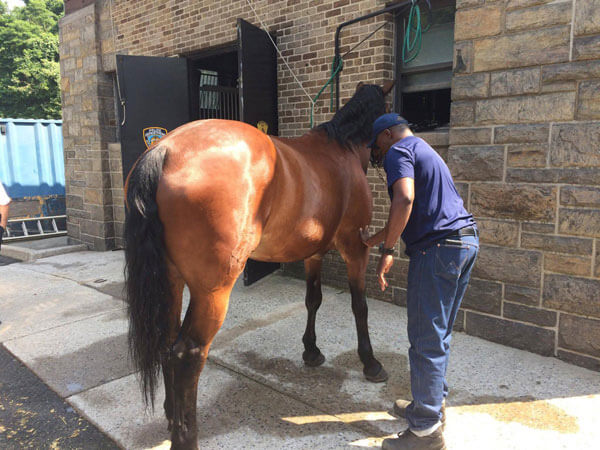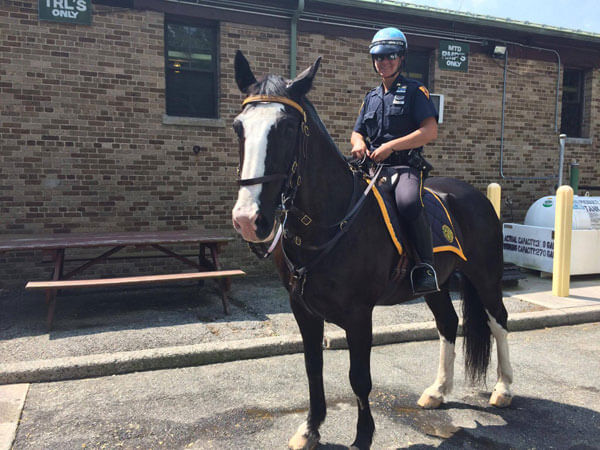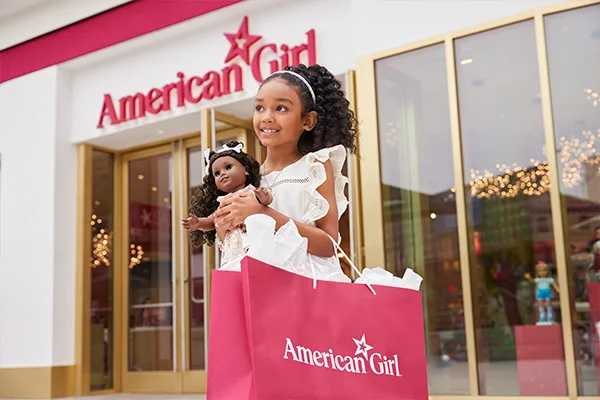By Angelica Acevedo
Mounted Police Officer Derek Ghee of the NYPD was grooming Chief, a golden brown, 5-foot-9-inch gelding he rides each day.
“I wanted to become a cop since I was a kid because of these horses, and now it’s been the best five years of my life,” Ghee said. “I can’t believe I get paid to do this.”
Similar sentiments were shared by the other officers in the Troop F barn, located in Cunningham Park.
Throughout the summer, police officers on horses — also known as the mounted unit — make regular appearances on Bell Boulevard. The officers and their steeds attract civilians each day they are out on the busy streets.
Lt. James O’Neill was assigned to Troop F last year and was asked to review the places the unit already covers. He then added more locations to the rounds, such as Alley Pond Park, Flushing Meadows Corona Park and, of course, Bell Boulevard.
“A lot goes into this. You want to make sure that it’s an area that’s conducive, that it’s safe for the horses and not too far,” O’Neill said. “Bell Boulevard used to be a post where mounted officers would go, and they haven’t gone there in several years.”
Perhaps one of the questions that quickly comes to mind is: Why does the mounted unit still exist?
O’Neill had many reasons as to why this, a tradition since 1858, is just as efficient as other units in the NYPD.
“A lot of people will notice a mounted officer before they’ll notice a patrol car, and the mounted officer has a much better vantage point because he’s up 10 feet,” O’Neill said. “It’s very good for crime prevention. A lot of times, just the presence of the horse will get people to calm down. The horse is very intimidating, but at the same time it’s also extremely inviting.”
O’Neill added that they have gotten a lot of positive feedback across the community.
“The public enjoys seeing us,” O’Neill said. “I think a lot of times it puts people at ease when they see a horse, especially at large gatherings. They gravitate towards them.”
Although some people express concern for the horses, O’Neill assures that the NYPD treats their horses “like gold.”
To be considered for the unit, he describes the process as extensive, involving a sometimes years-long waiting list and interviews that judge if an officer is suited for the position. Once an officer passes the first portion, they go through three months of intensive physical training.
“You get beat up pretty good and if you’re afraid of getting dirty or afraid of getting banged up, it’s just not gonna be the place for you,” O’Neill said.
O’Neill expressed great pride to be in the unit, although it took him many years to do so.
A native Long Islander, O’Neill began his police work in the 115th and 111th precincts in Queens, then worked in the Bronx and Harlem before he got to his position as lieutenant.
“Took me 15 years to get here, but it’s great,” O’Neill smiled.
Even so, he does not sugar-coat the amount of responsibility that comes with the position.
“These are huge animals and it’s a huge responsibility to work with them, so it’s not for everybody,” O’Neill said. “On the outside it looks great, people love it, but you really have to have a love of animals or you’re just not going to be happy.
There are 45 horses in the NYPD mounted unit, according to O’Neill. Most of them are geldings, as it was found that they possess the best temperament for the job.
Each gelding was specifically picked and trained, some starting at 4 years old. O’Neill said the horses tend to work in the unit for about 10 years, then they retire and live on a farm for their remaining days.
“The department pays for these horses to be cared for when they retire, so they have good lives once their service time is up,” O’Neill said. “They go to these retirement farms and we check on them to make sure they are being treated well.”
Each horse has a personalized name that matches their personality or appearance.
The officers express their preferences for their respective horses, much like a proud parent would his kids. According to O’Neill, officers get assigned a horse which helps them understand them while they’re out on the job.
“It’s useful because then they’ll know what the horse is afraid of, what it likes, what it doesn’t like,” O’Neill said. “You’ll get a feel for the horse, so you’ll know if something’s not right.”
When asked if there’s a certain bond formed between the officer and the horse, O’Neill first gave the “textbook answer” that although people like to believe that there is, the horse might not feel the same way.
“Some people don’t believe that there’s a real attachment between animals and humans, but you can see with some of these horses and riders that there definitely is an attachment,” O’Neill said.
He mentioned a particular case where this is evident.
“Ghee and Chief, there’s definitely a relationship between them and it’s quite amusing,” O’Neill said.
Five years ago, Chief was a first-time leased horse to the NYPD during the time Ghee was undergoing his training.
“They kind of saw this bond very early on,” O’Neill added. “It’s funny because they ended up buying Chief and then Ghee ended up getting assigned to him.”
“Horses have a very strong sense of smell, and when Ghee walks up to the barn, Chief’s stall is all the way at the end so he can’t see him, but he must pick up his scent because he’ll start whining,” O’Neill chuckled.
As Ghee groomed and cooled Chief off outside the barn, there was a sense of harmony between the two. The horse seemed completely at ease with the 6-foot-3 officer.
“Chief is fearless, but he’s such a sweet horse, very affectionate,” Ghee said.
Ghee remembered their time during his training fondly.
“I just wasn’t getting it, but then I got on Chief and I did,” Ghee said. “We’ve been joined at the hip ever since.”


































